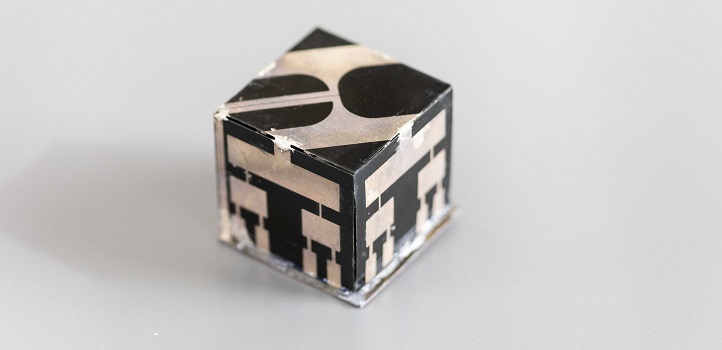Electrical Engineering
3D-printed cube dials into energy harvesting
Ambient energy emitted by cellular phones and modems can be captured and converted into electricity using unusually shaped technology.

As Internet-connected smart devices become smaller and more widespread, the challenge of powering them grows more acute. An inexpensive energy harvester developed at KAUST can help recharge Internet-of-things (IoT) gadgets using radio waves from wireless sources.
One way that researchers are miniaturizing devices for IoT applications is through an approach called system-on-package. Recent work has shown that the protective packaging around microelectronics devices could be used to accommodate components, such as communication antennas, for significantly reduced costs and space requirements.
Atif Shamim, a professor of electrical engineering and an expert in energy harvesting, realized that system-on-package principles could help IoT devices become more self-sufficient. His team investigated strategies to build highly compact antennas that tune into the radiofrequency signals emitted from mobile and wireless devices. They then teamed up with Khaled Salama’s group at KAUST to convert this energy into electricity using semiconductor diodes.
KAUST researchers are 3D printing a cube that grabs radio-frequency energy from the environment.
© 2019 KAUST
Most radiofrequency harvesters can only tap into a single part of the wireless spectrum, such as the 3G standard. Shamim’s team, however, aimed to produce a multiband device that can accumulate more energy from multiple sources of communication.
“Asking one antenna to do the job of several others simultaneously is tricky,” notes Azamat Bakytbekov, the first author of the paper. “You have to make sure the performance doesn’t drop at any one frequency point.”

Students Azamat Bakytbekov (left) and Thang Nguyen helped to develop a cube-shaped energy harvester that can gather power from a nearby smartphone.
© 2019 KAUST
The researchers turned to a cube-shaped package and the mathematical concept of fractals—patterns that repeat from small to large scale—to build their harvester. First, the team 3D printed a square plastic substrate and then screen printed fractal antennas on its surface using silver metal. Finally, they glued five of the plastic pieces together to form a cube, roughly five centimeters in size.
Fractal antennas can introduce multiple resonances that allow access to broader parts of the radio spectrum. The symmetric geometry of the cube worked to enhance this effect by gathering radiation all around the cube. Subsequent wireless spectrum scanning revealed several distinct frequencies where energy harvesting could work.
Experiments in real-world environments proved that the harvester could gather enough radio energy to power small wireless sensors. But the most interesting occurrence, according to co-author, Thang Nguyen, was when smartphone users passed by the 3D cube.
“We saw the power gathered by the cube suddenly shoot up when a person nearby made a call,” says Nguyen. “With the increase in mobile communication, this concept enables more and more radiofrequency energy to be harvested.”
References
- Bakytbekov, A., Nguyen, T.Q., Huynh, C., Salama, K.N. & Shamim, A. Fully printed 3D cube-shaped multiband fractal rectenna for ambient RV energy harvesting. Nano Energy 53, 587–595 (2018).| article
You might also like

Bioengineering
Smart patch detects allergies before symptoms strike

Computer Science
Green quantum computing takes to the skies

Electrical Engineering
Micro-LEDs boost random number generation

Bioengineering
Sensing stress to keep plants safe

Computer Science
Sweat-sniffing sensor could make workouts smarter

Electrical Engineering
New tech detects dehydration by touching a screen

Electrical Engineering
A new interface for efficient electronics

Electrical Engineering




